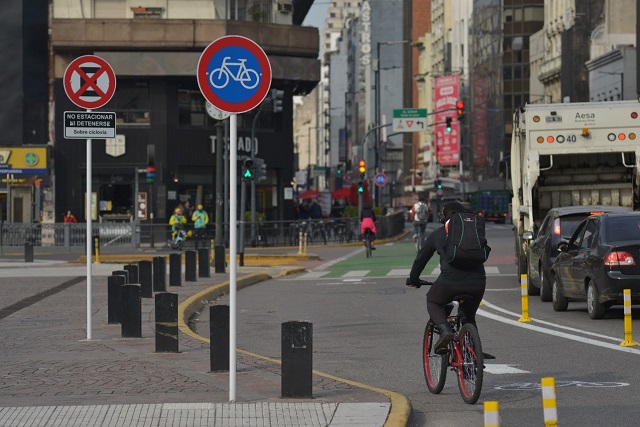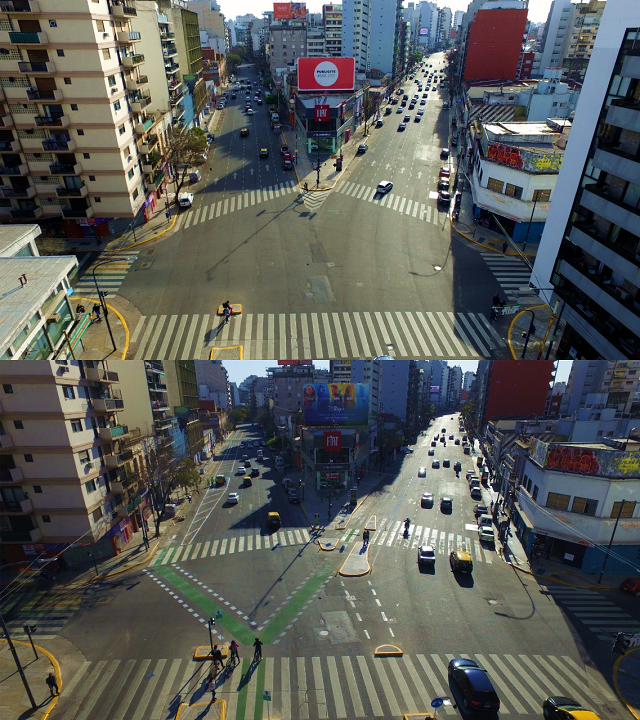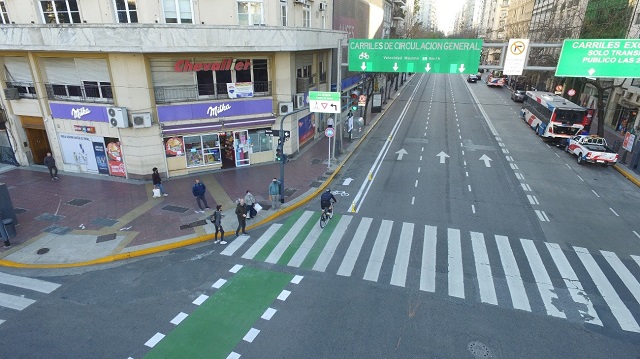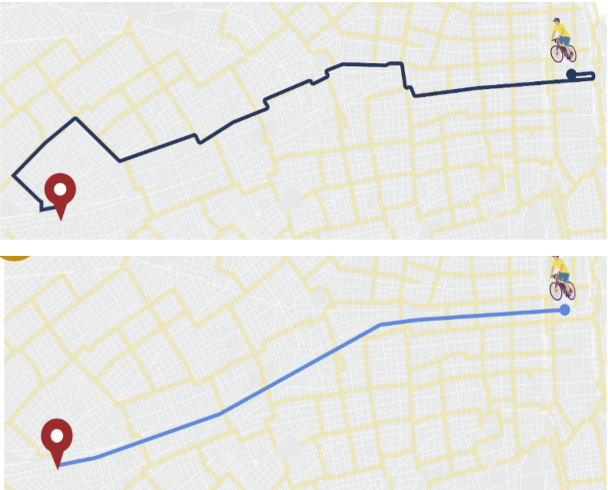
Bike infrastructure in Latin American cities has been growing fast over the last decade. Cities like Bogotá and Santiago have more than doubled the size of their cycling networks. This is good news, as studies have shown that cities that focus on safe infrastructure have a significant reduction in cyclist deaths and injuries and accrue significant economic benefits via reduced congestion and fewer sick days.
Yet, much of the cycling infrastructure in Latin American cities constructed to date has been built along local and secondary roads. Implementation may be easier on these less busy streets, but it also holds back the efficiency and overall impact of cycling and creates safety problems. Cyclists tend to look for shortcuts and the most direct routes, possibly creating dangerous interactions with cars when they venture onto arterials that are not designed for non-motorized road users.
The challenges posed by COVID-19 are beginning to change this paradigm, however. Some cities are transforming empty streets into safer areas for walking and cycling as fewer people commute and space for active mobility becomes more important. Sidewalks are being expanded to accommodate local commerce too.
Buenos Aires is one such city seeing significant shifts during the pandemic. Before COVID-19, Buenos Aires implemented most of its cycling network on local and collector streets. But since access to public transport has become restricted during lockdowns and many essential workers still need to commute, the need for more cycling space has become apparent.
In a city where half of commutes are less than 5 kilometers long, the bicycle is a clear choice. In August, the city presented a plan to add 60 kilometers of new cycle lanes on more than a dozen important avenues and began implementation. Putting cyclists in arterial roads requires major changes, from reducing speeds to giving cyclists wider bicycles lanes and more protection. The new bike lanes have a design that prioritizes comfort and physical distancing, with 3-meter-wide specifications, and efficiency, with unidirectional lanes that connect to important public transport hubs such as bus rapid transit and metro stations.
WRI Brasil provided support on the design of important intersections for this project to mitigate conflicts between cyclists and other vehicles. This support was part of a new phase in the Bloomberg Initiative for Global Road Safety, which just began a new six-year partnership with the Municipality of Buenos Aires.

#CiclovíasEnAvenidas
A big component of the new cycling plan is 17 kilometers of new cycle lanes on the major thoroughfares of Avenue Corrientes and Avenue Córdoba. These cycle lanes also come with a speed reduction for traffic, from 60 km/h to 50 km/h, and specific designs to accommodate loading and unloading zones since they are in commercial zones.
Carlota Pedersen-Madero, the advisor for the subsecretary of mobility planning for the Municipality of Buenos Aires, said the new lanes are intended to provide alternatives to occupancy-restricted public transport. The city has already noted a 45% increase in cyclists in these corridors after the lanes were added and they expect further growth in the future, perhaps as high as a 200-250% increase, she said. “We are changing the way that we move around the city.”

The new infrastructure on major avenues – being promoted by the city through the hashtag #CiclovíasEnAvenidas (“Cycle Lanes on Avenues”) – is not only improving the city’s cycling capacity but reducing travel times. Using the main avenues allows cyclists to safely take shorter and faster routes in many cases. Such efficiency gains as well as improved comfort levels may encourage more riders to try out pedaling.
Data shows that during certain periods of the day, there was a 113% increase in the number of cyclists on Corrientes Ave. and 146% increase on Córdoba Ave. The percentage of women cycling on Córdoba Ave. increased from 11% to 28% too, perhaps reflecting increased confidence in safety infrastructure.

Accelerating Sustainable Mobility Transformations
Despite these valuable steps, there is still room for improvement. As more cyclists hit the road, it’s important to also reduce speeds for cars to prevent deaths and injuries. A handful of cities across Europe are beginning to reduce speed limits to 40 km/h or even 30 km/h. Lower speeds will improve safety not only for cyclists, but for all road users since speed is the main risk factor for all road crashes.
At mid-block stretches, physical segregation of cyclists from cars is also a fundamental feature. Some of Buenos Aires’ new lanes have plastic bollards in place, but concrete barriers, vertical separation and other stronger materials can better protect cyclists from cars entering lanes. Safe intersections are also a key but complex feature for assuring the safety of new cyclists that frequently need iterative changes, including managing conflicts between turning vehicles, reducing approach speeds and providing better visibility for cyclists.
Like all new changes, it’s important to monitor and evaluate to understand how effective the new infrastructure is at protecting cyclists. Monitoring crashes and cyclist flow will also allow the city to better understand the benefits of these changes. The safer and more useful the infrastructure, the more people will feel comfortable using the system.
The pandemic has created rapid demand for safe walking and cycling infrastructure. Buenos Aires can be an important example for other Latin American cities to look to. With these changes, Buenos Aires is making a statement that cycling is not just a leisure option, but a major mobility mode for residents and planners. These changes not only respond to the need for safe mobility now. If realized as a greater shift towards multimodal mobility, they can help shift the city towards a more efficient, less polluting, more equitable future.
Bruno Rizzon is a Road Safety Analyst at WRI Brasil.
Bruno Batista is an Active Mobility Analyst at WRI Brasil.






